Related Research Articles

Tibetan Buddhism is the form of Buddhism practiced in Tibet and Bhutan, where it is the dominant religion. It also has adherents in the regions surrounding the Himalayas, in much of Central Asia, in the Southern Siberian regions such as Tuva, and in Mongolia.
The Bodhisattvacaryāvatāra or Bodhicaryāvatāra, sometimes translated into English as A Guide to the Bodhisattva's Way of Life, is a Mahāyāna Buddhist text written c. 700 AD in Sanskrit verse by Shantideva (Śāntideva), a Buddhist monk at Nālandā Monastic University in India which is also where it was composed.
Mahāyāna Sūtrālamkāra kārikā is a major work of Buddhist philosophy attributed to Maitreya-nātha as dictated to Asanga. The text, written in verse, presents the Mahayana path from the Yogacara perspective. It comprises twenty-two chapters with a total of 800 verses and shows considerable similarity in arrangement and content to the Bodhisattvabhūmiśāstra, although the interesting first chapter proving the validity and authenticity of Mahāyāna is unique to this work. Associated with it is a prose commentary (bhāṣya) by Vasubandhu and several sub-commentaries by Sthiramati and others; the portions by Maitreya-nātha and Vasubandhu both survive in Sanskrit as well as Tibetan, Chinese, and Mongolian translations.
The Buddhist doctrine of the two truths differentiates between two levels of satya in the teaching of the Buddha: the "conventional" or "provisional" (saṁvṛti) truth, and the "ultimate" (paramārtha) truth.

The Nyingma school is the oldest of the four major schools of Tibetan Buddhism, founded by Vajrayana revealer Guru Padmasambhava. "Nyingma" literally means "ancient," and is often referred to as Ngangyur, "school of the ancient translations" or "old school". The Nyingma school is founded on the first translations of Buddhist scriptures from Sanskrit into Old Tibetan in the eighth century, during the reign of King Trisong Detsen. The Tibetan alphabet and grammar was created for this endeavour.
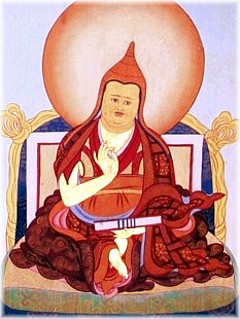
Jamgön Ju Mipham Gyatso, or Mipham Jamyang Namgyal Gyamtso (1846–1912) was a very influential philosopher and polymath of the Nyingma school of Tibetan Buddhism. He wrote over 32 volumes on topics such as painting, poetics, sculpture, alchemy, medicine, logic, philosophy and tantra. Mipham's works are still central to the scholastic curriculum in Nyingma monasteries today. Mipham is also considered one of the leading figures in the Ri-me (non-sectarian) movement in Tibet.
The Tibetan term Ngöndro refers to the preliminary, preparatory or foundational practices or disciplines common to all four schools of Tibetan Buddhism and also to Bon. They precede the Generation stage and Completion stage.

Khenpo Tsültrim Gyamtso Rinpoche is a prominent scholar yogi in the Kagyu tradition of Tibetan Buddhism. He teaches widely in the West, often through songs of realization, his own as well as those composed by Milarepa and other masters of the past. "Tsültrim Gyamtso" translates to English as "Ocean of Ethical Conduct".
The Svatantrika–Prasaṅgika distinction is a doctrinal distinction made within Tibetan Buddhism between two stances regarding the use of logic and the meaning of conventional truth within the presentation of Madhyamaka.

Śāntarakṣita ,, whose name translates into English as "protected by the One who is at peace" was an important and influential Indian Buddhist philosopher, particularly for the Tibetan Buddhist tradition. Śāntarakṣita was a philosopher of the Madhyamaka school who studied at Nalanda University under Jñānagarbha, and became the founder of Samye, the first Buddhist monastery in Tibet.

Bhāviveka, also called Bhavya or Bhāvaviveka was a sixth-century Madhyamaka Buddhist. In Tibetan Buddhism Bhāviveka is regarded as the founder of the Svātantrika tradition of the Mādhyamaka school of Buddhism, which is seen as antagonistic to Prāsaṅgika Madhyamaka.

Longchen Nyingthig is a terma, revealed scripture, of the Nyingma school of Tibetan Buddhism, which gives a systematic explanation of Dzogchen. It was revealed by Jigme Lingpa (1730-1798).
Pramana literally means "proof" and "means of knowledge". In Indian philosophies, pramana are the means which can lead to knowledge, and serve as one of the core concepts in Indian epistemology. It has been one of the key, much debated fields of study in Buddhism, Hinduism and Jainism since ancient times. It is a theory of knowledge, and encompasses one or more reliable and valid means by which human beings gain accurate, true knowledge. The focus of pramana is how correct knowledge can be acquired, how one knows, how one doesn't, and to what extent knowledge pertinent about someone or something can be acquired.
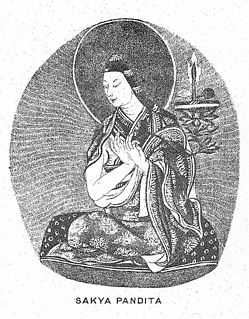
Sakya PanditaKunga Gyeltsen was a Tibetan spiritual leader and Buddhist scholar and the fourth of the Five Sakya Forefathers. Künga Gyeltsen is generally known simply as Sakya Pandita, a title given to him in recognition of his scholarly achievements and knowledge of Sanskrit. He is held in the tradition to have been an emanation of Manjusri, the embodiment of the wisdom of all the Buddhas.
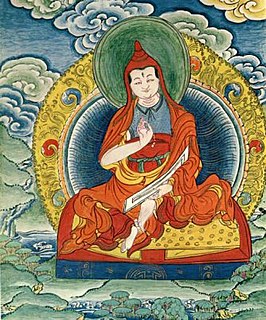
Vairotsana was a lotsawa or "translator" living during the reign of King Trisong Detsen, who ruled 755-97 CE. Vairotsana, one of the 25 main disciples of Padmasambhava, was recognized by the latter as a reincarnation of an Indian pandita. He was among the first seven monks ordained by Śāntarakṣita, and was sent to Dhahena in India to study with Śrī Siṅgha, who taught him in complete secrecy. Śrī Siṅgha in turn entrusted Vairotsana with the task of propagating the semde and longde sections of Dzogchen in Tibet. He is one of the three main masters to bring the Dzogchen teachings to Tibet, the two others being Padmasambhava and Vimalamitra, and was also a significant lineage holder of trul khor.
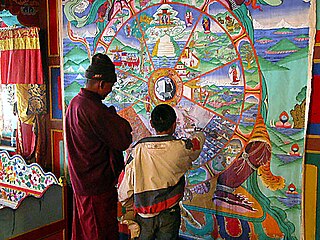
Shedra is a Tibetan word meaning "place of teaching" but specifically refers to the educational program in Tibetan Buddhist monasteries and nunneries. It is usually attended by monks and nuns between their early teen years and early twenties. Not all young monastics enter a shedra; some study ritual practices instead. Shedra is variously described as a university, monastic college, or philosophy school. The age range of students typically corresponds to both secondary school and college. After completing a shedra, some monks continue with further scholastic training toward a Khenpo or Geshe degree, and other monks pursue training in ritual practices.
Shenlha Ökar or Shiwa Ökar is the most important deity in the Yungdrung Bon tradition of Tibet. He is counted among the "Four Transcendent Lords" along with Satrig Ersang, Sangpo Bumtri, and Tonpa Shenrab Miwoche.
The Madhyamakālaṃkāra is an 8th-century Buddhist text, believed to have been originally composed in Sanskrit by Śāntarakṣita (725–788), which is extant in Tibetan. The Tibetan text was translated from the Sanskrit by Surendrabodhi and Jñānasūtra.
The Madhyamakāvatāra is a text by Candrakīrti on the Mādhyamaka school of Buddhist philosophy. It is a commentary on the meaning of Nagarjuna's Mūlamadhyamakakārikā and the Ten Stages Sutra. As such, within the Tibetan Buddhist canon this text is classified as commentarial literature.
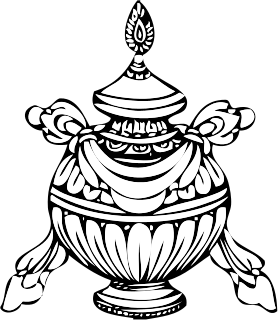
The Sheja Dzö or "Treasury of Knowledge" is a voluminous work by Jamgon Kongtrul (1813–1899). It is constituted by a root text in verse "The Encompassment of All Knowledge" and an autocommentary in prose, 'The Infinite Ocean of Knowledge'. The Treasury of Knowledge is widely considered Jamgon Kongtrul's masterpiece, covering the full spectrum of Buddhist history according to the knowledge then current in the Himalayas; the Abhidharma through the lens of Vasubandhu ; the Buddhist philosophy preserved, categorized and developed in the Himalayas; and the many streams of Buddhist sādhanā both exoteric (sutrayana) and esoteric (vajrayana), transmitted to, maintained and developed by the many trans-Himalayan lineages, such as Mahamudra and Dzogchen. The breadth of the Sheja Dzö is encyclopedic and its approach ecumenical. The root text in verse is terse and ostensibly glib approaching telegraphic. Whereas, the tone and register of the commentary is non-sectarian in regards to the many systems of Buddhadharma it enshrines. The Sheja Dzö is the central reference and general auspice work in Rimé movement literature.
References
- Murthy, K. Krishna. Buddhism in Tibet. Sundeep Prakashan (1989) ISBN 81-85067-16-3.
- Doctor, Thomas H. (trans.) Mipham, Jamgon Ju.(author)(2004). Speech of Delight: Mipham's Commentary of Shantarakshita's Ornament of the Middle Way. Ithaca: Snow Lion Publications. ISBN 1-55939-217-7
- Shantarakshita (author); Mipham (commentator); Padmakara Translation Group (translators)(2005). The Adornment of the Middle Way: Shantarakshita's Madhyamakalankara with commentary by Jamgön Mipham. Boston, Massachusetts, USA: Shambhala Publications, Inc. ISBN 1-59030-241-9 (alk. paper)
- Banerjee, Anukul Chandra. Acaraya Santaraksita in Bulletin of Tibetology, New Series No. 3, p. 1-5. (1982). Gangtok, Sikkim Research Institute of Tibetology and Other Buddhist Studies.
- Blumenthal, James. The Ornament of the Middle Way: A Study of the Madhyamaka Thought of Shantarakshita. Snow Lion, (2004). ISBN 1-55939-205-3 - a study and translation of the primary Gelukpa commentary on Shantarakshita's treatise: Gyal-tsab Je's Remembering The Ornament of the Middle Way.
- Prasad, Hari Shankar (ed.). Santaraksita, His Life and Work. (Collected Articles from "All India Seminar on Acarya Santaraksita" held on August 3–5, 2001 at Namdroling Monastery, Mysore, Karnataka). New Delhi, Tibet House, (2003).
- Jha, Ganganath (trans.) The Tattvasangraha of Shantaraksita with the Commentary of Kamalashila. 2 volumes. First Edition : Baroda, (G.O.S. No. Lxxxiii) (1939). Reprint ; Motilal Banarsidass, Delhi, (1986).
- Phuntsho, Karma. Mipham's Dialectics and Debates on Emptiness: To Be, Not to Be or Neither. London: RoutledgeCurzon (2005) ISBN 0-415-35252-5